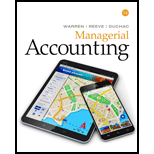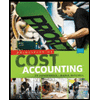
1.
Calculate the break-even point in sales units for the overall Product E for the current year.
1.
Explanation of Solution
Sales mix: It refers to the relative distribution of the total sales among the number of products sold by a company. In other words, it is expressed as a percentage of units sold for each product with respect to the total units sold for all the products.
Break-even Point: It refers to a point in the level of operations at which a company experiences its revenues generated is equal to its costs incurred. Thus, when a company reaches at its break-even point, it reports neither an income nor a loss from operations. The formula to calculate the break-even point in sales units is as follows:
Determine the break-even point in sales units for the overall Product E.
Fixed cost =$46,800
Contribution margin per unit =$10.40 per unit (3)
Working note (1):
Note: For break-even analysis, the Product-12” Pizza and Product-13” Pizza are considered as the components of one overall company’s Product E.
Determine the selling price per unit of Product E.
Working note (2):
Determine the variable cost per unit of Product E.
Working note (3):
Determine the unit contribution margin of Product E.
Therefore, the break-even point in sales units for the overall Product E for the current year is 4,500 units.
2.
Calculate the break-even sales (units) for Product-12” Pizza and Product-16” Pizza.
2.
Explanation of Solution
Determine the break-even point in sales units:
For Product-12” Pizza
Break-even point in sales units for Product E =4,500 units (refer Part a)
Sales Mix for Product Laptops =30%
For Product-16” Pizza
Break-even point in sales units for Product E =4,500 units (refer Part a)
Sales Mix for Product Tablets =70%
Therefore, the break-even point in sales units for the Product 12” Pizza is 1,350 units and for the Product 16” Pizza is 3,150 units.
3.
Compare the break-even point with that in Part (1).
3.
Explanation of Solution
The break-even point calculated in (1) with a sales mix of 50% 12” Pizza and 50% 16” Pizza is 4,680 units. It is more than the break-even point of 4,500 units calculated in Part 1.
The reason for the difference is the sales mix which is allocated at a lower percentage to the 12” Pizza (50%) and 16” Pizza (50%) in the present case. It resulted in the lower contribution margin per unit of $10.00 per unit than in Part 1 ($10.40 per unit). Thus, it increases the break-even point of sales (units) in the present case.
Working note (4):
Determine the break-even point in sales units for the overall Product E.
Fixed cost =$46,800
Contribution margin per unit =$10.00 per unit (7)
Note: For break-even analysis, the Product-12” Pizza and Product-16” Pizza are considered as the components of one overall company’s Product E.
Working note (5):
Determine the selling price per unit of Product E.
Working note (6):
Determine the variable cost per unit of Product E.
Working note (7):
Determine the unit contribution margin of Product E.
Working note (8):
Determine the break-even point in sales units:
For Product-12” Pizza
Break-even point in sales units for Product E =4,680 units (4)
Sales Mix for Product 12” Pizza =50%
Working note (9):
For Product-16” Pizza
Break-even point in sales units for Product E =4,680 units (4)
Sales Mix for Product 16” Pizza =50%
Want to see more full solutions like this?
Chapter 5 Solutions
Bundle: Managerial Accounting, 14th + Cengagenowv2, 1 Term Printed Access Card
- Tony sold a building to Carol. The sales price was $420,000. Tony paid a commission to a real estate broker of $22,000 and paid other selling expenses of $5,800. Tony's basis in the building was $285,000. What was Tony's gain realized on the sale of the building?arrow_forwardLila Corporation reported net sales of $80,000. The beginning accounts receivable was $15,000, and the ending accounts receivable was $21,000. What is the days sales collected for Lila Corporation? (Rounded answer to nearest day)arrow_forwardEleanor Technology, a firm with no net debt, reports cash flow from operations of $7,840 million in its cash flow statement after adding $2,250 million in accruals to earnings. It reported cash investments in operations of $4,680 million. What were Eleanor Technology's free cash flow and earnings for the period? Help me with thisarrow_forward
- Kaiser Industries earned an operating income of $35,500 with a contribution margin ratio of 0.40. Actual revenue was $320,000. Calculate the total fixed cost. Round your answer to the nearest dollar, if required.arrow_forwardProvide correct option accounting questionarrow_forwardA business has revenue of $895,000, cost of goods sold of $356,000, operating expenses of $198,000, and pays $82,000 in taxes, what is the net income?arrow_forward
- Zeta Corporation began the accounting period with $90,000 of merchandise, and the net cost of purchases was $310,000. A physical inventory showed $110,000 of merchandise unsold at the end of the period. The cost of goods sold by Zeta Corporation for the period is ____.arrow_forwardI am searching for the accurate solution to this accounting problem with the right approach.arrow_forwardHow does triple bottom line reporting enhance traditional financial statements? (a) It deals exclusively with social impacts (b) It only focuses on environmental costs (c) It measures profit, people, and planet impacts simultaneously (d) It reports financial profits three ways MCQarrow_forward
- Consider the overall effects on Peninsula Lawn Care from selling and performing services on account for $9,200 and paying expenses totaling $5,850. What is Peninsula Lawn Care's net income or net loss? A. Net loss of $3,650 B. Net income of $4,650 C. Net income of $7,800 D. Net income of $3,350 helparrow_forwardCan you help me solve this general accounting question using the correct accounting procedures?arrow_forwardKindly help me with this General accounting questions not use chart gpt please fast given solutionarrow_forward
 Managerial AccountingAccountingISBN:9781337912020Author:Carl Warren, Ph.d. Cma William B. TaylerPublisher:South-Western College Pub
Managerial AccountingAccountingISBN:9781337912020Author:Carl Warren, Ph.d. Cma William B. TaylerPublisher:South-Western College Pub Financial And Managerial AccountingAccountingISBN:9781337902663Author:WARREN, Carl S.Publisher:Cengage Learning,Principles of Accounting Volume 2AccountingISBN:9781947172609Author:OpenStaxPublisher:OpenStax College
Financial And Managerial AccountingAccountingISBN:9781337902663Author:WARREN, Carl S.Publisher:Cengage Learning,Principles of Accounting Volume 2AccountingISBN:9781947172609Author:OpenStaxPublisher:OpenStax College Cornerstones of Cost Management (Cornerstones Ser...AccountingISBN:9781305970663Author:Don R. Hansen, Maryanne M. MowenPublisher:Cengage Learning
Cornerstones of Cost Management (Cornerstones Ser...AccountingISBN:9781305970663Author:Don R. Hansen, Maryanne M. MowenPublisher:Cengage Learning Principles of Cost AccountingAccountingISBN:9781305087408Author:Edward J. Vanderbeck, Maria R. MitchellPublisher:Cengage Learning
Principles of Cost AccountingAccountingISBN:9781305087408Author:Edward J. Vanderbeck, Maria R. MitchellPublisher:Cengage Learning Managerial Accounting: The Cornerstone of Busines...AccountingISBN:9781337115773Author:Maryanne M. Mowen, Don R. Hansen, Dan L. HeitgerPublisher:Cengage Learning
Managerial Accounting: The Cornerstone of Busines...AccountingISBN:9781337115773Author:Maryanne M. Mowen, Don R. Hansen, Dan L. HeitgerPublisher:Cengage Learning





